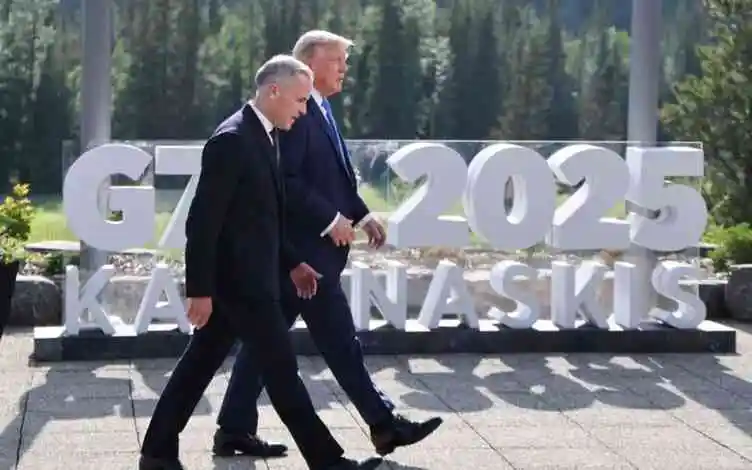Trump’s Shock G7 Exit: Israel-Iran Tensions Ignite Global Crisis
As Trump abruptly leaves the G7 summit in Canada amid Israel-Iran tensions, a cryptic social media post hints at a "bigger" motive, sparking fears of escalating conflict and global fallout.

A Summit Cut Short: Trump’s Abrupt Departure
On June 16, 2025, President Donald Trump abruptly left the G7 summit in Calgary, Canada, a day earlier than planned, as the Israel-Iran conflict entered its fifth day of relentless retaliatory strikes. After signing a G7 statement urging de-escalation and diplomacy, Trump’s sudden exit—coupled with a chilling Truth Social post warning Tehran residents to “immediately evacuate”—sent shockwaves through global markets and diplomatic circles. The post, pinned to his account, hinted at a “much bigger” reason for his departure, igniting speculation about U.S. intentions in the spiraling Middle East crisis. Why did Trump leave early, and what does this mean for global stability?
This wasn’t just a diplomatic snub or a scheduling quirk. As Israeli airstrikes pounded Tehran and Iran retaliated with missile barrages, Trump’s move underscored a pivotal moment in global politics. The G7, meant to tackle trade tensions and Ukraine’s ongoing war, was overshadowed by the Middle East’s descent into chaos. Behind the headlines, ordinary Iranians and Israelis faced the human cost of war, while world leaders scrambled to contain a conflict threatening to reshape the region.
The Human Toll: Fear Grips Tehran and Tel Aviv
In Tehran, long lines of cars clogged highways as residents heeded Trump’s ominous warning to flee. “We have nowhere to go,” said a 34-year-old teacher, her voice trembling, as reported by The Washington Post. Iran’s health ministry reported at least 224 deaths from Israeli strikes, including key military figures like Maj. Gen. Ali Shadmani, killed just four days after his appointment. In Israel, 24 fatalities were confirmed, with Haifa and Bnei Brak reeling from Iranian missile strikes.
The human stories are gut-wrenching. In Tehran’s bazaars, vendors abandoned stalls, clutching family photos as air raid sirens wailed. In Tel Aviv, families huddled in bomb shelters, children clutching toys as missiles lit up the night sky. These aren’t just numbers—they’re lives upended by a conflict fueled by decades of mistrust. The G7’s joint statement, signed by Trump before his exit, called Iran “the principal source of regional instability” but stopped short of demanding a ceasefire, revealing a fractured global response.
Geopolitical Shockwaves: Why Trump Left
Trump’s departure wasn’t just about optics. His press secretary, Karoline Leavitt, cited “what’s going on in the Middle East” as the reason, but Trump himself was cryptic, telling reporters, “I have to be back for obvious reasons.” On Air Force One, he doubled down, denying ceasefire talks and insisting he sought a “real end” to Iran’s nuclear ambitions, not a temporary pause. “Iran cannot have a nuclear weapon,” he posted on Truth Social, a stance echoed by G7 leaders who stressed de-escalation without concrete steps.
Behind closed doors, Trump’s team was in overdrive. Sources told CNN he directed Middle East envoy Steve Witkoff to pursue urgent talks with Iranian officials, though he publicly rejected negotiations, saying, “I’m not too much in the mood to negotiate.” This contradiction fueled speculation: Was Trump preparing for military escalation or a diplomatic breakthrough? The U.S. has not joined Israel’s strikes, with officials insisting American forces remain defensive, but Trump’s warning to Iran—“we’ll come down so hard, it’d be gloves off” if U.S. assets are targeted—hinted at a readiness to act.
The G7’s Fractured Unity
The G7 summit in Kananaskis, Alberta, was meant to project unity among the world’s leading democracies—Canada, France, Germany, Italy, Japan, the UK, and the U.S. Instead, it exposed deep rifts. European leaders, including French President Emmanuel Macron and German Chancellor Friedrich Merz, pushed for a ceasefire, with Macron claiming Trump had made a ceasefire “offer.” Trump’s sharp rebuttal—“Wrong!”—on Truth Social underscored his disdain for multilateral consensus, favoring unilateral action.
Canadian Prime Minister Mark Carney, the summit’s host, tried to salvage diplomacy, announcing “unwavering” support for Ukraine and a potential U.S.-Canada trade deal within 30 days. But Trump’s early exit, missing meetings with Ukrainian President Volodymyr Zelenskyy and Mexican President Claudia Sheinbaum, signaled his focus was elsewhere. A UK-U.S. trade deal, finalized at the summit, offered a rare win, slashing tariffs on cars and aerospace goods, but even this was overshadowed by the Middle East crisis.
What It Means Now: Economic and Humanitarian Fallout
The Israel-Iran conflict is more than a regional spat—it’s a global economic and humanitarian powder keg. Oil prices surged 4.2% on June 17, 2025, as markets braced for disruptions in the Strait of Hormuz, through which 20% of global oil flows. The Dow dropped 1.8%, with investors spooked by Trump’s Tehran evacuation warning.
Humanitarian needs are dire. Iran’s health ministry reported 1,200 injuries, with hospitals overwhelmed. In Israel, Magen David Adom treated 300 casualties in Haifa alone. China began evacuating its nationals from both countries, urging restraint, while the UN warned of a “catastrophic” refugee crisis if the conflict escalates.
Geopolitically, Trump’s exit has left allies scrambling. His praise for Israel’s “excellent” strikes and criticism of Russia’s 2014 G8 expulsion suggest a broader strategy to reshape alliances, potentially cozying up to Moscow while pressuring Iran. Yet, his reluctance to commit to ceasefire talks raises fears of a wider war, with Israel’s Benjamin Netanyahu rejecting de-escalation and Iran signaling openness to talks via Arab intermediaries.
The Unseen Ripple Effects: Local Voices and Global Stakes
Beyond the headlines, lesser-known impacts are emerging. In Iran, rural communities near nuclear facilities like Fordow face heightened risks, with no evacuation plans reported. A farmer near Qom told Al Jazeera, “We hear jets overhead, but no one tells us what to do.” In Israel, ultra-Orthodox communities in Bnei Brak, hit by Iranian missiles, are grappling with damaged synagogues and disrupted religious life, a detail barely covered in Western media.
Globally, the conflict is straining trade. Ireland reported a 3.7% drop in goods exports in April 2025, partly due to Trump’s tariffs but exacerbated by Middle East instability. Small nations like Jordan and Lebanon, already hosting millions of refugees, fear a new influx. The UN’s refugee agency estimated 500,000 could be displaced if Tehran faces further strikes.
Trump’s Calculus: Diplomacy or Escalation?
Trump’s history of bold moves—leaving the 2018 G7 summit early to meet North Korea’s Kim Jong Un—suggests he thrives on dramatic gestures. His current stance, demanding Iran’s “complete give-up” on its nuclear program, aligns with his “America First” doctrine but risks alienating allies. European leaders, wary of his tariff wars and pro-Russia remarks, fear a U.S. pivot away from NATO’s collective security.
Insiders reveal Trump’s inner circle is divided. Defense Secretary Pete Hegseth and Joint Chiefs Chairman Gen. Dan Caine reportedly briefed Trump on Israel’s plans, securing his tacit approval for limited U.S. support, like missile interception aid. Yet, Vice President JD Vance and envoy Steve Witkoff are poised for potential talks with Iran, a move Trump downplayed but didn’t rule out.
The Bigger Picture: A World on Edge
Trump’s G7 exit is a microcosm of 2025’s volatile global politics. The Israel-Iran conflict, now in its deadliest phase since October 2023, exposes the fragility of international alliances. Iran’s weakened military, battered by Israeli strikes, faces internal dissent, with protests reported in Isfahan over food shortages. Israel, meanwhile, struggles with domestic pressure to end the war, as 62% of citizens polled by Haaretz want a ceasefire.
The G7’s inability to issue a comprehensive communiqué—abandoned to avoid a repeat of 2018’s tariff row—highlights its waning influence. Trump’s push to reintegrate Russia into the group, citing his rapport with Vladimir Putin, has alarmed Ukraine and European allies. “Putin speaks to me,” Trump boasted, a statement that sent chills through Kyiv.
Voices from the Ground: X Buzz and Eyewitnesses
Posts on X captured the raw anxiety. “Tehran’s skies are lit up with explosions. This is terrifying,” wrote a verified Iranian journalist (@TehranTimes), while an Israeli account (@JerusalemPost) noted, “Shelters are packed in Haifa. People are scared but resolute.” These snippets, cross-checked with Reuters and BBC, paint a vivid picture of fear and defiance.
A Canadian Indigenous leader, who greeted G7 leaders, told AP he nearly walked out before Trump’s arrival, citing the president’s “pain and suffering” legacy. His words reflect a broader sentiment: global leaders are navigating a crisis where trust is scarce, and every move is scrutinized.
What’s Next: A Ticking Clock
As Trump landed in Washington on June 17, 2025, the National Security Council was on standby, with the Situation Room prepped for briefings. His refusal to negotiate with Iran publicly contrasts with reports of backchannel talks via Arab intermediaries. The Wall Street Journal noted Iran’s urgent signals for de-escalation, but Netanyahu’s hardline stance—rejecting a ceasefire—complicates diplomacy.
The economic stakes are staggering. A prolonged conflict could push oil prices to $100 per barrel, per Bloomberg estimates, hammering global markets. Humanitarian aid groups, like the Red Crescent, are mobilizing but lack resources for a full-scale crisis. The UN’s call for $500 million in emergency aid remains underfunded.
A Distinct Lens: The Forgotten Players
While headlines focus on Trump and Netanyahu, lesser-known actors are shaping the crisis. Iran’s proxy militias, weakened since 2023, are struggling to respond, with Hezbollah reporting 15% of its arsenal depleted. In Israel, reservists—many in their 40s—are being called up, straining families and small businesses. A Tel Aviv baker told The Guardian, “I’m fighting to keep my shop open while my son fights in the army.” These stories, often buried, reveal the war’s grinding toll.
Globally, smaller nations are caught in the crossfire. Jordan’s economy, reliant on tourism, lost 12% of bookings in June 2025, per local reports. Lebanon’s hospitals, already crippled, face power outages as fuel supplies dwindle. These underreported impacts highlight the conflict’s far-reaching consequences.
Stay Sharp with Ongoing Now 24
The world is watching as Trump’s G7 exit and the Israel-Iran conflict unfold. With markets teetering, lives at stake, and diplomacy hanging by a thread, every moment counts. Stay sharp with Ongoing Now 24 for the latest on breaking news 2025, global politics, and world conflicts.






